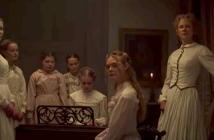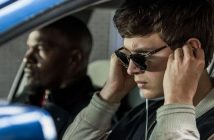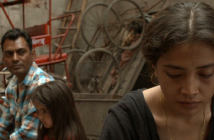
Editor’s Note: The following review is part of our coverage of TIFF’s winter film series On the Road: The Films of Wim Wenders. For more information, visit tiff.net and follow TIFF on Twitter at @TIFF_NET.
Back in the 1940s, ‘50s, and ‘60s, father and son musicologists John and Alan Lomax traveled the American South in search of previously unrecorded and undocumented music styles and songs for the Library of Congress. Their trips resulted in many new discoveries like Muddy Waters and many rediscoveries (locating of previously recorded artists that had been more or less forgotten) like Son House, Mississippi John Hurt and Leadbelly (Huddie Ledbetter). This kind of journey was important to American music, tracking the roots and origins of many of the musical styles that have become popular over the decades. It was in this tradition that Ry Cooder, a marvelous guitarist and legendary side musician, and his son Joachim went to Cuba in the mid-1990s to locate local musicians that time and the public had largely forgotten.
Wenders is one of the few directors that, like his fellow countryman Werner Herzog, switches easily between the worlds of fiction filmmaking and documentary filmmaking.
Cooder’s journey started in the 1970s when he and his wife went to Cuba to see if they could find the musicians on an unlabled tape of Cuban music he’d acquired and adored. Their trip was unsuccessful, but years later, spurred on by an idea from a record producer friend of his, he went back and started locating these musicians that had been forgotten after the Cuban revolution in the 1950s. He found many musicians and singers and recorded an album in 1996, then in 1998 he returned for another recording session and brought along the great German director Wim Wenders to document it and a series of concerts.

Wenders is one of the few directors that, like his fellow countryman Werner Herzog, switches easily between the worlds of fiction filmmaking and documentary filmmaking. He takes a more active approach to filming than others, avoiding the stale ‘talking heads’ style in favor of a more cinéma vérité style, keeping things moving and giving the film as much visual energy as it has aural energy with the exciting and vibrant music that is featured. He uses a lot of different sound techniques for the film, most notably a lot of sound bridges, elements of sound that carry us from one shot to the next, and overlaying some of the musician’s stories in narration form with shots of them interacting with their community through their music.
He also employs a steady-cam frequently, moving around and getting in close to the performers while they’re recording or while they’re telling their stories of what they’d been doing before Cooder recruited them for this project. Many if not all of them were not working in music and had not been for many years, yet they all still maintained their talents. Wenders films them sensitively, without judgement and without preference to subject. Each person profiled is important to him and to the project.
The amazing thing about Buena Vista Social Club is not Wenders or Cooder getting these men and women together but what happens when they are together.
The amazing thing about Buena Vista Social Club is not Wenders or Cooder getting these men and women together but what happens when they are together. The music made by this group is astounding, and even more so when you consider that most of the people you’re watching were in their 80s and 90s when they were making this film! They play with the vigor and dexterity of people in their 20s and each of them have a vitality that many lose by their 50s. Their musical (and physical) agility is remarkable and their overwhelmingly positive outlook on life is more than affirming.
The studio sessions and the interviews are only part of this exemplary film. The most invigorating parts are from a concert that was put on in Amsterdam, gathering these artists in front of a sold-out crowd. Their interplay with the audience is fantastic, egging on responses from the crowd and basking in the appreciation that has been denied them all these years in their native Cuba. These people are born performers and it is an amazing site to see them lapping up the applause and getting more intense in their music as a result.
The final section of the film is devoted to the group getting to play Carnegie Hall in New York. Anyone in the musical community knows that Carnegie Hall is the ultimate destination for any performer, and they kept asking Cooder “When will we get to play Carnegie Hall? When will we get to go to America and New York?”. Their wish was fulfilled, though tragically this performance at Carnegie Hall also marked the end of the Buena Vista Social Club. Their concert, though not shown in its entirety, is full of the life shown in their concert in Amsterdam but the group seems even more lively given that this is the top of the heap. The crowd is quick to give standing ovations that are certainly earned by the group. Their joy is felt by the people in the audience, not just their crowd in Carnegie Hall, but anyone watching the film too.
That is the real gift of the film: the joy that anyone watching will have while seeing these consummate performers get to fulfill their dreams. Whether you’re watching in a theater or at home by yourself, the optimism and joy these musicians exude is infectious. The main source is the subjects on screen, but it’s amplified by Wenders’ camera work and editing. If he’d gone with a more traditional approach, it’s likely that some sections would have fallen flat despite the subjects.
Documents like Buena Vista Social Club are among the most important documentary filmmaking has to offer. This, like the more recent Searching for Sugarman, serves to introduce the world to talent that should have been recognized decades ago and gives new life to people long forgotten. One of the worst crimes in art is to forget great talent. An even greater crime is to not appreciate great talent at all. Buena Vista Social Club seeks to right the wrong of these talented individuals being ignored for so long and gives us a document for the ages to always be enjoyed. A large measure of the thanks should go to Cooder and Wenders for appreciating that this project was needed, but the biggest thanks should go to Compay Segundo, Eliades Ochoa, Ibrahim Ferrer, Omara Portunondo, Ruben Gonzalez, Orlando ‘Cachaito’ Lopez, Amadito Valdes, Manuel ‘Guajiro’ Mirabal, Barbarito Torres, Pio Leyva, Manuel ‘Puntillita’ Licea, and Juan de Marcos Gonzalez for being who they are and that they were willing to put aside their lives to return to making the music they loved so long ago and making it with the same fever and energy that they did when they were in their 20s and 30s. Buena Vista Social Club will always stand as a testament to their great ability and to their magnificent music.
Documents like Buena Vista Social Club are among the most important documentary filmmaking has to offer. This, like the more recent Searching for Sugarman, serves to introduce the world to talent that should have been recognized decades ago and gives new life to people long forgotten.



